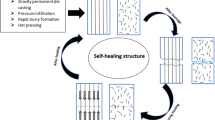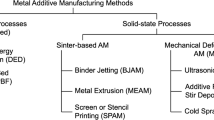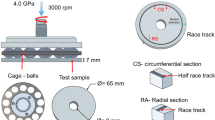Abstract
The effect on high-temperature embrittlement of introducing a through-thickness notch in a multidirectional silicon carbide fiber-reinforced calcium-aluminosilicate glass-ceramic composite was investigated through tensile testing, microdebonding, and light and scanning electron microscopy techniques. The fracture mechanism of the composite changed from notch insensitive at room temperature to notch sensitive at elevated temperatures due to increased fiber-matrix bond strength caused by oxidation effects at interfaces exposed to the oxidative environment. Stress concentration and bending effects at the notch tip resulted in growth of the notch through fibers in a planar fashion covering the entire fracture surface. This was contrary to the case of an unnotched composite, for which two distinct fracture surface regions were observed as planar embrittlement zones at the periphery and fibrous at the center. Cracks in the notched composite were more closed relative to those in the unnotched one, except at the notch tip. Concentration of the stress at the notch tip increased the high-temperature embrittlement effect on the composite.
Similar content being viewed by others
Author information
Authors and Affiliations
Rights and permissions
About this article
Cite this article
Kahraman, R., Sunar, M. Notch-Sensitive Fracture Behavior of a Silicon Carbide Fiber-Reinforced Glass-Ceramic at Elevated Temperatures. J. of Materi Eng and Perform 7, 104–107 (1997). https://doi.org/10.1007/s11665-006-5011-4
Received:
Issue Date:
DOI: https://doi.org/10.1007/s11665-006-5011-4




